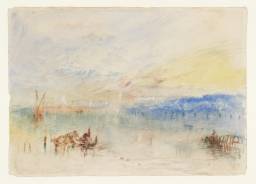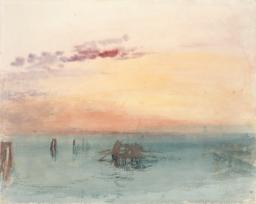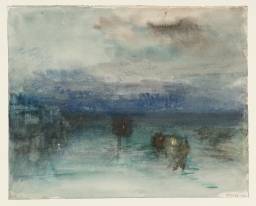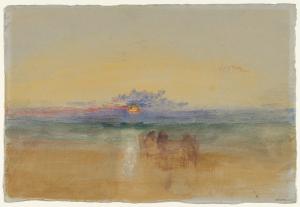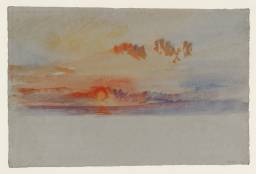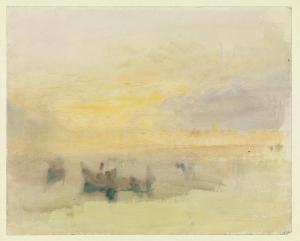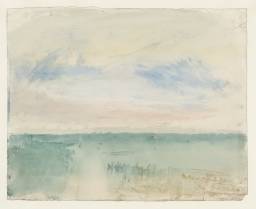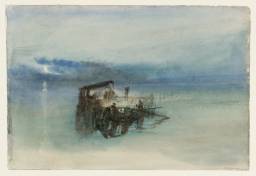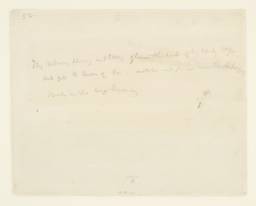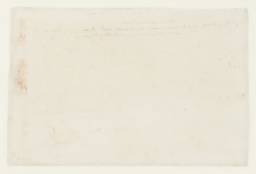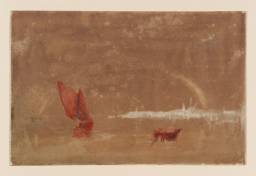Turner Bequest CCCXVI 16, 25, 39, CCCXVII 12, 17, 18, CCCLXIV 137, 332, 334
This grouping of watercolours includes views across the open, shallow tidal waters of the extensive Lagoon (the Laguna) around Venice, connected by inlets to the Adriatic Sea and characterised by areas of marshland and mud flats traversed by deeper dredged channels. These works are associated with Turner’s last visit to the city through the similarities of their media, supports and techniques to those of more readily recognisable topographical subjects in parallel subsections of this catalogue, as discussed in the technical notes of individual entries; for the dating of the Venetian watercolours in general, see the Introduction to the tour.
Most of these ‘views’ lack specific landmarks or distinctive details such as Venetian or Adriatic shipping or local costume to rely on visual identification alone; they have aspects in common with the many English Channel coast and Alpine lake scenes of Turner’s later career, where the focus is on the relationship between broad stretches of water and the sky under various weather conditions and at particular times of day, notably at sunrise or sunset or by moonlight, as seen in some of the works here. Compare many such watercolour studies among the ‘Lowland and River Colour Studies c.1820–40’, ‘Coastal Scenes and Shipping c.1820–45’ and ‘Margate, London and Surrey c.1829–45’ sections of the present catalogue, as well as the finished Blue Rigi, Sunrise of 1842, one of the culminating watercolours arising from the annual Swiss tours of 1841–4 (Tate T12336).1 Often called ‘colour beginnings’,2 such scenes can sometimes be related to completed works, as in the case of D32153 (Turner Bequest CCCXVI 16), but many of them appear to have been sufficiently expressive of light and mood for Turner as they stand, without his taking them further.
Among the works here, Ian Warrell has related D32162, D32176, D35980 and D36190 (CCCXVI 25, 39, CCCLXIV 137, 332) in particular, declaring that they ‘were evidently painted during one working session, so that it is possible to locate the same range of colours throughout the batch, as if watching Turner move from sheet to sheet’. He has suggested that the shift ‘from warm golden sunlight to cool blue moonlight perhaps also reflects something of his interest in colour theory at this date, for it was in 1840 that Turner read and annotated the English translation of [Johann Wolfgang von] Goethe’s treatise on colour’3 by Charles Lock Eastlake, the Theory of Colours (originally Zur Farbenlehre). Warrell continued:
These notes reveal that Turner questioned many of Goethe’s ideas. There were, however, various points upon which the two agreed, including the idea of there being established visual polarities, such as warm and cool, light and dark, which converge with ideas of proximity and distance, or conceptions of strength and weakness. It would be perfectly natural for Turner to experiment with these in private sketches, where he could adumbrate the potential of colour contrasts.4
Early in the previous decade, Turner had made extensive drafts of poetry which appear to relate to his unfinished oil painting The Evening Star (Turner Bequest, National Gallery, London),7 an elemental twilight beach scene, in the Worcester and Shrewsbury sketchbook (see under Tate D22279; Turner Bequest CCXXXIX 70); he continued to submit brief verses supposedly extracted from his own ‘Fallacies of Hope’ for the catalogue entries accompanying his Royal Academy exhibits,8 as well as evocative passages by poets such as Byron, as in the case of Venice, the Bridge of Sighs, shown in the spring of 1840 prior to his last visit to the city (Tate N00527).9 The transitory sunset and moonlight effects evoked in two of the watercolours here (D32162, D36192; CCCXVI 25, CCCLXIV 334) appear to have inspired the artist to attempt suitable if fragmentary phrases on their versos (D40157 and D40182 respectively). Warrell has observed: ‘What can be deciphered hints at his sensory engagement with the way Venice was transformed by different transient effects.’10
Inscriptions on other 1840 sheets (versos of Tate D32158, D32173; D40176; Turner Bequest CCCXVI 21, 36, 37) appear to allude to Byron’s Venetian poetry. Outside the Turner Bequest, the 1840 watercolour Venice, Storm at Sunset (Fitzwilliam Museum, Cambridge) also seems to have verse written on the back,11 as does a contemporary view of San Giorgio Maggiore from the Hotel Europa, at the Entrance to the Grand Canal (Whitworth Art Gallery, Manchester).12
See Eric Shanes, ‘Beginnings’ in Evelyn Joll, Martin Butlin and Luke Herrmann (eds.), The Oxford Companion to J.M.W. Turner, Oxford 2001, pp.21–3; among many other accounts, see also Andrew Wilton in Martin Butlin, Wilton and John Gage, Turner 1775–1851, exhibition catalogue, Royal Academy, London 1974, p.26; and Wilton 1979, p.187.
Ian Warrell in Warrell, David Laven, Jan Morris and others, Turner and Venice, exhibition catalogue, Tate Britain, London 2003, p.235, citing John Gage, ‘Turner’s Annotated Books: “Goethe’s Theory of Colours”’, Turner Studies, vol.4, no.2, Winter 1984, pp.34–52.
Martin Butlin and Evelyn Joll, The Paintings of J.M.W. Turner, revised ed., New Haven and London 1984, pp.252–3 no.404, pl.406 (colour).
See Andrew Wilton and Rosalind Mallord Turner, Painting and Poetry: Turner’s ‘Verse Book’ and his Work of 1804–1812, exhibition catalogue, Tate Gallery, London 1990, pp.180–1.
How to cite
Matthew Imms, ‘Venice: The Lagoon 1840’, subset, September 2018, in David Blayney Brown (ed.), J.M.W. Turner: Sketchbooks, Drawings and Watercolours, Tate Research Publication, December 2019, https://www

